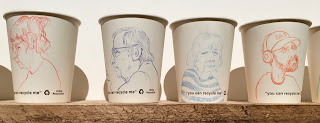Rambert Dancers performed ‘Bring your own’ in collaboration with (LA)HORDE at Hall for Cornwall, Truro October 31st 2025
Rambert have been changing. They used to present very beautiful abstract works, lots of dancers in skintight colourful costumes, often performing in unison with impressive skill.
The skill, commitment and unison moves are still there but the mood has changed.
In the first piece, ‘Hop(e)storm.’ Women threw themselves at men, who dragged them back to be left at a distance. This was repeated for about five minutes, followed by the couples instead dancing in wildly exaggerated Lindy hop inspired ways, to mostly strange electronic noises. Some of it was humerous, all of it energetic.
This was followed by ‘Weather is sweet’ . The relevance of the title was unclear. Dancers interacted in ways suggesting sexual contact, although later in the question session we were told the bottom pushing down to the floor movements were inspired by basket ball. It was very inventive and rather puzzling with circus elements, a savage playground of lots of yanking of bodies, jittery, masturbatory gestures and no feeling - like an automated fury of sex. The sound was unpleasant electronic noises but mercifully not too loud.
Lastly after the interval we saw ‘Room with a view’. Not at all a reference to EM Forster or Noel Coward. In this a varied crowd of dancers moved with increasing frenzied unpleasantness, running in circles, gesturing rudely at the audience, shouting and ending up looking like a group of medieval flagellants.
I found it a tedious overload of exhausting menace and despair.
The audience were very appreciative of it all. The screamers and whoopers were in. I couldn’t see anyone else refraining from applause in protest at being trapped as the focus of abusive angry outpouring. Turning the house lights on briefly emphasized the assault. Maybe the applause was just admiration for the dancers‘ stamina or identification with alienated rage?.
To be sure it was very competently done.
The Q and a session was mildly interesting but no critical questions were asked - my waving hand was not selected. It was admitted that the response at all venues was not always so supportive. In Cornwall we don’t get much post modern dance to see and hear so maybe anything however agonised is welcome drama.
I wished the online reviews had been more informative of the ordeal offered.
I will consider carefully if I want to attend next year - Rambert have removed themselves from the aesthetically pleasing with a vengeance with this programme.
















